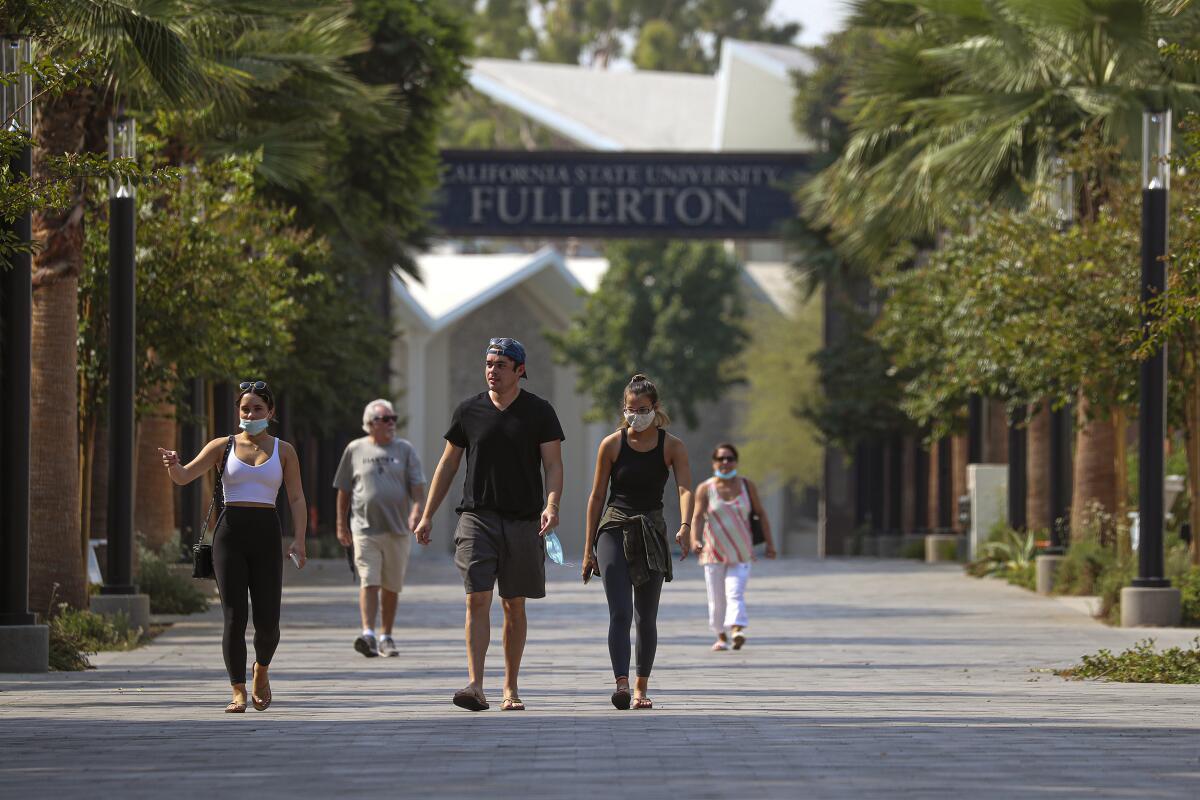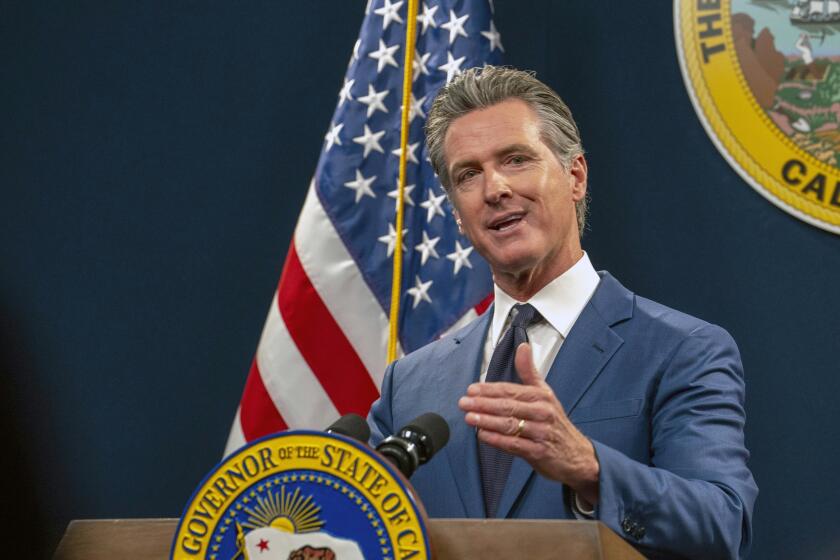CSU unveils massive venture to provide free AI skills and training across all 23 campuses

- Share via
- California State University will provide free AI tools and training to all students, faculty and staff on 23 campuses.
- Top tech companies will join academics on an advisory board to help identify AI skills needed in the California workforce.
- Industry partners will also provide internships and apprenticeships to give students real-world experience with AI on the job.
California State University on Tuesday unveiled what is believed to be among the largest and most ambitious efforts in higher education to champion artificial intelligence with an initiative to provide tools and training in the groundbreaking technology across the system’s 23 campuses.
With generative AI’s ability to create new content learned from training data, CSU is working to ensure students in the nation’s largest and most diverse public university system have equitable access to the technology. Nearly half of CSU’s 450,000 students are low-income and about 30% are the first in their families to attend college.
The university has enlisted Gov. Gavin Newsom’s office and nearly a dozen leading tech companies — including Microsoft, Meta, Nvidia, OpenAI, Intel, LinkedIn, Amazon Web Services and Alphabet — to join academics on an advisory board to help identify AI skills needed in the California workforce and provide advice on how best to teach them. Industry partners will also provide internships and apprenticeships to give students real-world experience with AI on the job.
“We are proud to announce this innovative, highly collaborative public-private initiative that will position the CSU as a global leader among higher education systems in the impactful, responsible and equitable adoption of artificial intelligence,” CSU Chancellor Mildred García said in a statement. “The comprehensive strategy will elevate our students’ educational experience across all fields of study, empower our faculty’s teaching and research, and help provide the highly educated workforce that will drive California’s future AI-driven economy.”
Industry leaders called the initiative a model for higher education during a news conference Tuesday at San Jose State University.
“The impact and the scale of what’s happening here is really setting an inspirational example of what can happen when educational institutions, the government and industry partners come together and help students,” said Brian Johnsrud, director of education, learning and advocacy at Adobe.
The 23-campus Cal State University system is shifting its goalpost. Four-year degrees are still important but so are good jobs as consumers question the value of college.
Ed Clark, CSU’s chief information office, said the effort started last year, after tech leaders told Newsom’s office they could not find enough Californians or Americans overall equipped with the AI skills demanded by companies. Although 30 of the world’s top 50 AI firms are based in California, they were hiring internationally for more than half of the related workforce, Clark said.
CSU leaders said they were also growing concerned by a new “digital divide” among its campuses, with some racing forward to offer AI tools and training to students and others without the resources to do so.
“We cannot afford to leave some of our institutions behind during this time of dramatic change,” Nathan Evans, deputy vice chancellor for academic and student affairs, told the Board of Trustees during a briefing on the initiative last week.
Cal State Channel Islands, one of the system’s smaller campuses with about 5,000 students, could not afford the $500,000 annual price tag for campuswide access to AI tools, said Jill Leafstedt, dean for extended university and digital learning. Some faculty were using it to enrich their teaching, including an environmental sciences professor who developed a bot named Marlowe that uses humor and a pirate’s voice to help students learn to write scientifically. But others “barely dabbled” in the technology, she said.
The new CSU initiative will even the playing field for all, she said.
“The smaller campuses don’t have the buying power and resources for this, so this is really a matter of equity and getting this in the hands of all students regardless of the campus they go to,” she said.
CSU has developed a systemwide “AI Commons Hub” that provides free access to such tools as ChatGPT 4.0, a chatbot that can answer questions, assist with writing, help brainstorm, provide coding help and perform other tasks using human-like conversations. The university licensed the technology, customized for education, from OpenAI for all CSU students, faculty and staff — more than 500,000 users that marks the largest deployment of ChatGPT in the world, said Leah Belsky, the firm’s general manager of education.
Trainings include lessons on how to construct an effective prompt and ethical use of the technology. Other resources are offered by partners, including Microsoft’s Copilot, which can help summarize information and automate tasks such as writing emails, creating presentations and analyzing spreadsheets in Word, Excel, PowerPoint and other company products.
Gov. Gavin Newsom unveiled a plan Monday to create more well-paying career pathways for Californians who may not have a college degree.
The hub will provide professional development for faculty, including training on how to create lesson plans that both encourage the use of the technology in safe and responsible ways and “AI-proof” assignments so students don’t simply turn to ChatGPT do all of the work. Some faculty have reported widespread cheating that they tie to AI.
Others are concerned about bias — one study found, for instance, that when AI screened job applications, it disproportionately rejected women because the dataset used to train it included more men as successful employees.
But in a resolution last year, the Academic Senate commended Garcia’s office for providing funding and professional development to explore AI skills for teaching and learning and encouraged more of it.
“AI can be used for good and bad,” Clark said, adding that the advisory board will help address faculty and community concerns about bias, academic integrity, intellectual property and privacy.
Clark said he encourages students to use AI in his courses at Cal State Fullerton but requires that they note how they used it in their assignments. “They can’t take responsibility for something that was generated by an AI,” he said. “We’re not going to tolerate academic dishonesty.”
But AI can help students learn, spark creativity and gain confidence, educators say. In his information systems course at Fullerton, Clark said, many students who used AI to create a business plan for a coffee shop produced stellar projects — all of them different, demonstrating independent thinking. AI might have spurred ideas on creative designs, for instance, or “talked” through flaws of the proposed plan, but the oral presentations required students to demonstrate their mastery of concepts learned in class, Clark said.
“It’s a very interactive tool that serves, in many ways, as a tutor along with the class materials,” he said.
He said resistance toward AI today is similar to bans against using calculators during exams years ago because educators believed students should know how to do the math manually. Today, calculators are allowed even during SAT math tests — and AI skills should be widely embraced in part because employers are demanding them, CSU officials say.
According to LinkedIn, a platform that provides employment forecasts, along with professional networking and career development, hiring for AI jobs has grown 30% faster than overall hiring in the last year and 300% over the last eight years.
CSU, which graduates 125,000 students each year, with alumni accounting for 10% of the California workforce, is determined to prepare them for the new job opportunities.
“Right now, AI is transforming every field, from academia to the workforce,” Clark said. “We need to ensure that our students graduate with the knowledge of how to use these tools.”
More to Read
Sign up for Essential California
The most important California stories and recommendations in your inbox every morning.
You may occasionally receive promotional content from the Los Angeles Times.













